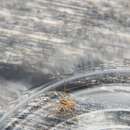Conservation Status
provided by University of Alberta Museums
According to the Committee on the Status of Endangered Wildlife in Canada (COSEWIC 2005a, 2005b) this species is not in any risk category.
- license
- cc-by-nc
- copyright
- University of Alberta Museums
Cyclicity
provided by University of Alberta Museums
Males have been collected from late May to early August and females from June to September (Dondale & Redner 1990; Pickavance 2001).
- license
- cc-by-nc
- copyright
- University of Alberta Museums
Distribution
provided by University of Alberta Museums
Alaska to Labrador, south to Vancouver Island, Wyoming, northern Michigan and northern New England. Greenland. Europe (Dondale & Redner 1990).
- license
- cc-by-nc
- copyright
- University of Alberta Museums
General Description
provided by University of Alberta Museums
Pardosa hyperborea is the only representative of the Pardosa saltuaria group in Canada (Dondale & Redner, 1987). Carapace (dorsal portion of the head region or cephalothorax) narrow, light brown, with two longitudinal dark brown stripes that go from the posterior end just to the anteiror eye row, clypeus (portion between anterior eye row and border of carapace) same color as sides; longitudinal dorsal mid line light brown, less conspicuous near postero-median eyes. Mouthparts: Chelicerae yellowish, darker in the apex; labium and endites same color as chelicerae. Sternum (plate between legs) dusky with a medial lighter patch. Coxae (1st leg segment) and femora (3rd leg segment) light brown; patella (4th leg segment), tibia (5th leg segment), metatarsi (7th leg segment) and tarsi (8th leg segment) darker, tibia with three inconspicuous lighter rings. Abdomen dark brown with a longitudinal medial light band bordered by a non continuous black line on each side, venter of abdomen lighter. Males and Females are similar in coloration and size but males are usually smaller; length ranges between 4.5 to 5.5mm. Male palp (see additional picture, articulated appendages anterior to 1st pair of legs): Terminal apophysis (ta in image) big, longer than wide, median apophysis (ma in image) small, with two projections, anterior projection short, posterior projections straight, directed backward, prominent. Female epigynum (see additional picture, located in the anterior ventral side of the abdomen): Two well separated anterior hoods (h in image), median septum (s in image) large, prominent and flat, lateral plates (lp in image) angular, laying below septum.
- license
- cc-by-nc
- copyright
- University of Alberta Museums
Habitat
provided by University of Alberta Museums
Alpine tundra, spruce, balsam fir and jack pine forests (Dondale & Redner 1990, 1994).
- license
- cc-by-nc
- copyright
- University of Alberta Museums
Life Cycle
provided by University of Alberta Museums
Pardosa hyperborea as most of Lycosid species, is a ground-dwelling species that usually prefer open areas, such as rocky hillsides or among lichens (Dondale & Redner 1990), peatlands or sphagnum bogs (Nordstrom & Buckle 2002), and is also common in burned areas (Buddle et al 2000). There is no information about life cycle of this species, but it could be inferred from related species (Pickavance 2001; Buddle, 2000), that P. hyperborea may have a two-year life span from hatching to maturity, overwintering the first time as immature and a second time as subadult, showing a superposition of different cohorts during the year. Mating should occur during June or July when both sexes are present, it has been reported females with egg sacs in July and August (Dondale & Redner 1990).
- license
- cc-by-nc
- copyright
- University of Alberta Museums
Trophic Strategy
provided by University of Alberta Museums
Generalist predator, no information available.
- license
- cc-by-nc
- copyright
- University of Alberta Museums
Pardosa hyperborea
provided by wikipedia EN
Pardosa hyperborea is a species of wolf spiders in the family Lycosidae.[1][2] It is found in North America, Greenland, Europe, and Russia (European to Sibiria).[2][3]
References
- license
- cc-by-sa-3.0
- copyright
- Wikipedia authors and editors
Pardosa hyperborea: Brief Summary
provided by wikipedia EN
Pardosa hyperborea is a species of wolf spiders in the family Lycosidae. It is found in North America, Greenland, Europe, and Russia (European to Sibiria).
- license
- cc-by-sa-3.0
- copyright
- Wikipedia authors and editors

